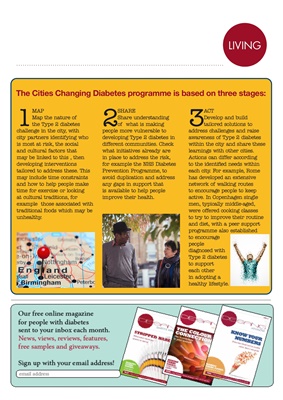
KITLIVING
1
MAP
Map the nature of
the Type 2 diabetes
challenge in the city, with
city partners identifying who
is most at risk, the social
and cultural factors that
may be linked to this , then
developing interventions
tailored to address these. This
may include time constraints
and how to help people make
time for exercise or looking
at cultural traditions, for
example those associated with
traditional foods which may be
unhealthy.
The Cities Changing Diabetes programme is based on three stages:
2
SHARE
Share understanding
of what is making
people more vulnerable to
developing Type 2 diabetes in
different communities. Check
what initiatives already are
in place to address the risk,
for example the NHS Diabetes
Prevention Programme, to
avoid duplication and address
any gaps in support that
is available to help people
improve their health.
3
ACT
Develop and build
tailored solutions to
address challenges and raise
awareness of Type 2 diabetes
within the city and share these
learnings with other cities.
Actions can differ according
to the identified needs within
each city. For example, Rome
has developed an extensive
network of walking routes
to encourage people to keep
active. In Copenhagen single
men, typically middle-aged,
were offered cooking classes
to try to improve their routine
and diet, with a peer support
programme also established
to encourage
people
diagnosed with
Type 2 diabetes
to support
each other
in adopting a
healthy lifestyle.